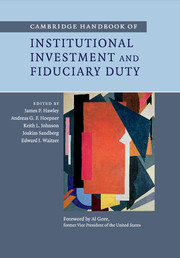Book contents
- Frontmatter
- Contents
- List of figures
- List of tables
- List of contributors
- Foreword
- 1 Introduction
- Part I Fiduciary duty: a global outlook
- Part II Fiduciary duty and the landscape of institutional investment
- Part III Challenging conventional wisdom on fiduciary duty
- Part IV Towards a broader interpretation of fiduciary duty
- 20 Fiduciary duty and the search for a shared conception of sustainable investment
- 21 Pension fund fiduciary duty and its impacts on sustainable investing
- 22 Reason, rationality and fiduciary duty
- 23 Socially responsible investment and the conceptual limits of fiduciary duty
- 24 Fiduciary duty at the intersection of business and society
- 25 Challenging conventional wisdom: the role of investment tools, investment beliefs and industry conventions in changing our interpretation of fiduciary duty
- Part V Beneficiaries’ roles and viewpoints
- Part VI Fiduciary duty and governance
- Index
- References
20 - Fiduciary duty and the search for a shared conception of sustainable investment
Published online by Cambridge University Press: 05 April 2014
- Frontmatter
- Contents
- List of figures
- List of tables
- List of contributors
- Foreword
- 1 Introduction
- Part I Fiduciary duty: a global outlook
- Part II Fiduciary duty and the landscape of institutional investment
- Part III Challenging conventional wisdom on fiduciary duty
- Part IV Towards a broader interpretation of fiduciary duty
- 20 Fiduciary duty and the search for a shared conception of sustainable investment
- 21 Pension fund fiduciary duty and its impacts on sustainable investing
- 22 Reason, rationality and fiduciary duty
- 23 Socially responsible investment and the conceptual limits of fiduciary duty
- 24 Fiduciary duty at the intersection of business and society
- 25 Challenging conventional wisdom: the role of investment tools, investment beliefs and industry conventions in changing our interpretation of fiduciary duty
- Part V Beneficiaries’ roles and viewpoints
- Part VI Fiduciary duty and governance
- Index
- References
Summary
Introduction
The trust is a means of conserving and transferring assets to nominated beneficiaries (Langbein 1997). Regulating the behavior of trustees, the principle of fiduciary duty governs the relationship between trustees and beneficiaries (Thomas and Hudson 2004: s. 1.56). In some jurisdictions, it also enables intermediaries to represent the interests of beneficiaries, providing the former with authority to invest on behalf of the latter. There are a variety of definitions of fiduciary duty ranging from the abstract through to the domain-specific. Atiyah (1995: 255) observed that a fiduciary relationship binds trustees to beneficiaries such that “the person in the fiduciary position is under a duty not to abuse that position, and this duty involves the duty to disclose all material facts.” Stapleton (1996: 13) noted, in relation to company directors and senior executives, being a fiduciary also involves “honesty and loyalty, and a duty of care and skill.” Langbein (2007: 1075) observed the “core fiduciary principle … is the duty of impartiality”; a rule conceived and policed so as to regulate conflicts of interest.
The chapter begins with the historical significance of fiduciary duty (see also Hawley and Williams 2001). This allows us to understand fiduciary duty in relation to functionally efficacious common law norms and conventions. Whereas some might suggest that fiduciary duty evolved as the standard of behavior because of its effectiveness in maximizing social welfare, it is important to acknowledge the idealism about past communities of practice, which is embedded in such claims. This is illustrated by a rereading of two landmark cases that effectively defined the nature and scope of fiduciary duty, relevant to investment management. I suggest that whatever its ideal conception, it has proven insufficient as the golden rule governing the trust institution. Government policies designed to define and regulate the governance of the trust institution represent attempts to solve problems evident in the practice of investment.
- Type
- Chapter
- Information
- Publisher: Cambridge University PressPrint publication year: 2014



